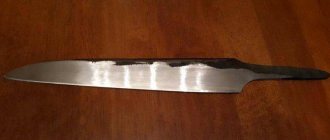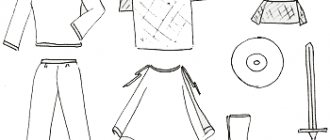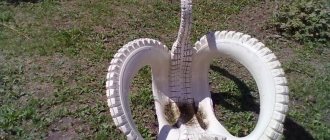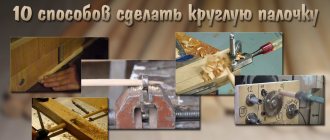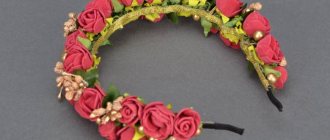To mow grass at the dacha or in villages, a hand scythe is still widely used. However, many people do not know how to maintain it in working order. But this is the most finely tuned tool among agricultural implements. And the main question when handling a scythe is how to maintain the sharpness of its blade for fruitful work. Today's topic is devoted to how to beat a braid for high-quality sharpening. However, first of all, let’s look at what kind of braids there are in principle, and what each of them is used for.
Three types of braids
The most common of the entire family of braids is the Lithuanian braid. Its name comes from ancient times, when they were cast from steel and then only forged. Litovkas were made on a par with swords, so the steel in them was of the same quality. Nowadays they are made by stamping from tool steels, so the Lithuanian braid holds the cutting edge well and sharpens well. They are available in several sizes to make it easier to mow grass in different conditions. For beginners, it is better to choose No. 7, it is easier to manage.
The pink salmon braid is used in places where there are a lot of hummocks and uneven areas. Its shape resembles a large sickle. It can also be easily recognized by its curved handle.
A serpan scythe, the blade of which is quite short compared to the others, is used for dry herbs.
Of all the varieties of braids, the Lithuanian braid has gained the most popularity. There are several sizes: No. 5, 6, 7, 8, 9 and 10. All of them are measured in decimeters, and the length of the blade varies from half a meter to a meter. When choosing such a braid, size is of great importance. The shorter the blade length, the easier it is to mow areas with uneven surfaces and in forests, between trees. The more flat and open the terrain, the longer the blade. Using the Lithuanian example, we will study in detail how to beat off a braid, and what tools we will need for this.
Also, the length of the braid was traditionally chosen based on the individual characteristics of a person: height, build and physical strength. After all, the larger the scythe, the heavier it is, and given that it receives strong resistance from the grass, you need to have good physical characteristics.
To make it convenient to harvest grass, the scythe tool must be very sharp. Before sharpening it must be beaten off. This is done so that the cutting edge becomes denser, thinner, and remains sharp longer. In order for the scythe to be a truly necessary tool that is convenient to work with, it must be beaten before sharpening. If you don’t do this, but simply sharpen it, such equipment will, at best, be enough for ten minutes of work, and then you will need to sharpen it again. Therefore, now we will study in detail how to properly cut a braid so that it cuts well and does not become dull for a long time.
Secrets to keep in mind
To understand the beating process, let's turn to physics or even metallurgy.
The fact is that in the process of plastic deformation at temperatures below recrystallization, hardening is accompanied by an increase in strength and hardness, as well as a decrease in ductility and toughness.
It’s easier to say, by beating the scythe, not only does the sting become thinner, but we also strengthen the blade due to hardening. But there are a few secrets that should be kept. We take into account the rebound without slanting, and so:
- The hammer must be harder than the scythe, otherwise when struck it will simply flatten itself, and not the surface we need.
- The headstock on which the hammering occurs must be harder than the hammer. The reason is the same, so that there are no dents or chips on it. For this, a file is often used, since it is harder than a hammer.
- The headstock should be smooth and slightly convex, this makes it easier to orient the braid.
- Do not beat off the toe of the knife; leave about 5-7 cm to the tip. The optimal cutting width is 2 mm, along the entire length of the braid. Otherwise, the sting will simply crush under the pressure of a thick stem or pebble.
- During the hammering process, you should periodically wet the hammer with water so that the hammer strip is always wet. Water cools the metal and removes tiny particles of dust and dirt. This way you can also see the rebound process better.
- Do not try to immediately stretch the metal to the desired length in one area, this can lead to bending. It is better to beat in small sections of 5-7 cm, going through several times.
- There is no need to make a perfectly straight blade. The presence of small waves in the plane of the knife even helps to mow the grass.
- After lights out, you need to walk with a fine-grained block. This will not only sharpen the blade, but also create microscopic nicks on it. Oddly enough, a perfectly sharp blade cuts worse.
- The maximum load when mowing falls on the area closer to the heel of the knife. You should pay more attention to it, both when cutting and when sharpening.
- If, during mowing, the blade collides with an object such as a wire or something similar, you should stop and walk the bar over the knife a couple of times.
- A scythe that has never been broken will require a master at least an hour to put it in order.
As practice shows, there are still a lot of small details. But a person comes to them himself, with experience.
Do you use a scythe breaker?
Not really.
Tool preparation
To cut a braid efficiently, you need to have a straight headstock without dents from repeated use. Usually they are ground on machines. And, of course, you will need a smooth hammer, which also should not have a bumpy surface or bevels from impacts. A high-quality tool is convenient to use because everything is visible, and the results of impacts are predictable. If the hammer or headstock is uneven, then during impacts, unwanted dents may appear, which, if not removed in a timely manner, can damage the blade.
P O P U L A R N O E:
DIY garden bench
Every family today has such a necessary attribute - a toilet. Over time, the old toilet is replaced with a new, beautiful, fashionable design. What to do with an old toilet?
Today we will recycle an old toilet, or rather one of its components - the drainage tank.
Today, almost every home has a printer, laser or inkjet.
Sometimes you have to print photos, cards, etc. on larger paper.
Afterwards you will need to trim the paper exactly to the required size.
To do this, you don’t have to buy a machine; you can make it yourself.
Where to get or what to make a grandmother from
These simple devices are sold in specialized stores. Of course, it’s easier to find them online than to find a department for mowers in the city. If you couldn’t find a headstock, you can make it yourself. After all, by and large, it’s just a piece of steel. Large files and springs are ideal; an old hammer can also be secured and used. It is very important to choose a material from sufficiently hard steel. Because if it is very soft, then the hardened scythe will crush it when struck. And the resulting irregularities can significantly damage the cutting edge.
A Christmas tree is not a stick
It’s not enough to choose a braid, you still need to plant it. They put a wooden stalk on the braid. The ideal material for a braid is a small Christmas tree cut down in the forest. Raw spruce wood takes a long time to dry; if you need a scythe urgently, you will have to look for dried spruce. To attach the braid, an oblique cut at 10–15 degrees is made at the thick end of the braid - the heel of the braid will be attached to it.
“If you make the cut steeper, the braid will mow in stripes, and the mow will look like the hairstyles of some young people now: a strip with hair, a strip cut bald,” the interlocutor jokes.
Usually, wooden wedges and crimp rings are used to fasten the scythe, but the wedges often dry out and the braid begins to move, making it impossible to work like this.
“At competitions I saw that many men put an elastic band between the wedge and the heel of the scythe to eliminate this defect,” says Vasily Adamovich. – Mowers from Yakutia generally wrap the place where the scythe is attached with metal tape for strength. But we fasten the braid differently, and I like our method better.
In the Urals, a metal ring with a bolt is often used to fasten the scythe; the device is very reliable. The bolt can be tightened as you work, which is very convenient. But for some reason no one produces such devices now.
A clamp with a bolt is the most reliable, according to Vasily Novikov, method of fastening a braid. Photo: Alexey Kunilov
We begin the process of beating the braid
So, the headstock is driven into the deck, and the blade itself is removed from the handle. This will make it more convenient to work. If you don’t want to remove it, then you need to provide a stand for the handle, with the help of which a regular scythe can be placed in a convenient position for beating.
Before use, the blade is immersed in water for half an hour, where it becomes darker. This is necessary in order to see the edge that is formed after the blows are made. It will be much lighter than the rest of the surface.
The scythe is placed on the headstock with the cutting edge facing you, after which they begin to hit it from the heel, without applying much force and as if pulling the steel in their direction. The hammer must be brought in when hitting from the side of the scythe, and the movements must be completed as if pulling it towards you. Thus, the metal begins to be gradually pulled in the required direction. Don't rush and speed up the process with stronger blows. This can result in an uneven edge that can cause waves, or the blade becomes deformed altogether. In this case, the braid will be damaged. You should do everything slowly, because beating a braid with a hammer is a rather labor-intensive process that requires gradual and patient progress.
In order for the cutting edge to be forged smoothly, it is necessary to shift with each blow, moving evenly from the heel to the end of the blade. After the first flattening, the entire edge should remain smooth, without wavy bends. If somewhere you can see that there are dark places left, it means that this place was not forged properly. Very carefully, using even weaker blows than usual, you need to fix everything so that the surface becomes uniform. Then they beat the other side in the same way. After this, they look: if the edge is not riveted enough, they begin to make the same movements again, from the heel to the end of the blade, until the desired effect is achieved. And thus, by taking turns riveting first one side, then the other, the blade is brought to the desired thickness. Over time, when more experience appears, the question of how to break off a scythe will not be so pressing. Everything will be done in fewer approaches and less time.
How to mow?
The braid is taken with the left hand by the braid above the handle, and with the right hand - the handle itself, grabbing it from above. Place the right leg in front, the left leg behind, turn the body slightly to the left, bend slightly - and begin to mow in a circular motion from right to left.
The scythe may encounter a stone or bump, causing part of the blade to bend to the side and become dull. To correct a damaged blade, the mower must always carry with him a spatula (Fig. 31, d) - a birch bark case 1, attached to the belt with a strap 2. The case contains a sharpening stone 3 and a smooth steel rod 4. In order to bring the blade into order, stick the end of the braid into the ground, wipe the knife with a bunch of grass, take a steel rod, press it against the damaged area of the blade and straighten it so that it takes a normal position. After this, the blade is sharpened with a whetstone.
If a good scythe knife is chosen, it is correctly (as described above) adjusted to the mower, skillfully sharpened and beaten, then such a scythe is easy to work with.
Source: Small mechanization in household plots and farms. Ed. I.P. Oil. 1996
Sharpening the scythe
The braid is sharpened in two stages. The first is scraping, the second is editing. Scraping is necessary to make the surface smooth and remove excess metal. A scraper is used for this. It is made from a triangular file, from which the rough surface is ground off on a machine, thus making its edges sharp. The Lithuanian scythe is sharpened only on one side - the one that is on top during work. To scrape, you need to hold the scythe at the heel and run the scraper along the blade along to the very edge. This needs to be done several times, while creating a constant sharpening angle. When burrs begin to appear on some parts of the cutting edge, this means that scraping is finished and it’s time to start straightening. To do this, use an emery block. It is used in the same way as with a scraper, trying to maintain the same sharpening angle. It is very important that the angle is the same as when scraping, because by changing it a little, you can, on the contrary, dull the braid.
Sharpening stones
Any gardening tool gradually wears out and becomes dull. In order to quickly sharpen a hand scythe, or straighten a cutting edge, you will need a sharpening stone. But it is necessary to take into account the quality of the metal on the scythe knife. If the knife has a good grade of steel, then it cannot be sharpened with a simple stone; you will need a special sharpening stone.
Shape of stones
Rectangular stones are a fairly large abrasive with a smooth surface.
They are convenient for processing large surfaces. But unfortunately, when working with such stones, it is difficult to process curved profiles of parts and blades with concave surfaces.
To properly sharpen a scythe, it is better to use oval stones. They fit comfortably in the hand, and thanks to their rounded shape, they will fit over the entire surface of the scythe knife.
Choosing a braid
We have fully studied how a braid is beaten and then sharpened, now it’s worth telling how this tool is chosen. Now that there are many varieties of braids and their manufacturers, low-quality products are very common. Moreover, braids - even in Soviet times, when everything was only according to GOST standards, it was difficult to find high-quality ones. Usually, out of three, one was good, and the rest were made of unsuitable steel. Now it doesn’t matter how much a braid costs; even among very expensive models there are often bad ones. In general, it is better to check this delicate instrument yourself before purchasing.
Do It Yourself (Ogonyok) 1997-02, page 66
A. Pivovarchik DZ braid!
ABOUT KOSOVISHCHE ITSELF
® Kosovischa (Fig. 1) are made in our area from young spruce. It is advisable to select a tree of such size that it requires less planing. They cut down a Christmas tree in winter (the tree is stronger). The spruce is dried in the bark and not in the sun, so that there are fewer cracks. They make braids from birch, and sometimes from pine. Less commonly planed from ash. These are already masters who respect their in-
For the handle of the scythe, select a rod (made of oak or buckthorn) of small length, but with a margin, so that the final size can be determined later according to the hand. The diameter of the rod is about 3 cm. A small depression is cut out in the middle of the rod (Fig. 2, a) in the form of a trough (the thickness of the part remaining after trimming is approximately 1/3 of the diameter of the rod). Before bending an oak rod, it is better to boil it (at least
tools and those who know how to hold a plane, choose ash for the scythe. The lower part of such braids is hexagonal, the upper part is round. Such braids are planed not from thin wood, but from blanks that are obtained by splitting the trunk of an adult ash tree.
The length of the mower depends on the height of the mower and is usually 15–20 cm greater than this height.
bend point) in water for 5 minutes. 10, and then bend it around a round mandrel with a diameter of about 3 cm.
A buckthorn rod can be heated (in the bark) over a fire by pouring a little water into the cut out trough. When the bark burns, the rod is ready for bending. If the pen doesn't work out the first time, don't despair! The second one will definitely come out better! When the curved handle dries, it is cut
Source
Traditional methods for checking the quality of braids
The first method: you need to take a piece of window glass and run it along the blade. If the glass is not going well, you get the feeling that it is clinging to something, which means you shouldn’t take such a scythe. Her steel is soft and will be more trouble than good. There are even such specimens that when you conduct this experiment, metal shavings are removed from their surface. Naturally, with such a tool, the question of how to properly cut off a braid will not even arise due to its unsuitability. Ideally, the glass should pass smoothly along the blade without leaving the slightest mark on it. The second method: you need to place a match across the tip of the scythe blade, balancing it, and gently push it from one side. If the match turns, then it is a quality braid.
There are more stringent methods of verification. You need to take a metal nail and run it across the blade. If it remains without visible defects, and even better, shavings are removed from the nail, then this is a 100% high-quality tool that will last for decades. Of course, durability also depends on how the scythe is beaten when using it.
You can hit the tree with the butt of the scythe. If the sound is high and extended, the braid is good. You can also rest the end of it against a board on the floor and press from above. If the steel bends evenly and returns to its previous position when released, such a braid is worth buying.
Grandfather's inventory
The result of mowing depends entirely on whether the tool is properly prepared. At the same mowing tournament, Vasily Adamovich Novikov more than once witnessed how even experienced participants broke the fastenings of their scythes and handles in the midst of the competition. The hand scythe still remains a purely individual tool that cannot be put into production. Yes, the plant in Artyah offers ready-made solutions for completing a hand scythe: a metal scythe, handles, standard fasteners, but the majority of mowers, according to Vasily Adamovich’s observations, come to the competition with scythes prepared in the same way as their grandfathers and great-grandfathers did. Novikov himself will turn 70 in March next year, but every year he goes to the mowing tournament, and recently he also takes with him a team of four fellow villagers, men and women, whose scythes he also prepares.
“At competitions, the mower needs to walk 100 meters without rest,” says Vasily Novikov. – I once covered this distance with a scythe in 6 minutes. But I am already over 60 years old, there are no age groups at the competitions, and thirty-year-olds compete equally with me. It’s already hard for me to compete with them. Therefore, I prepared a replacement, Oleg Zubkov , he won first place the year before last, in the past he was second, and I was fourth.
The handle of the scythe should be rotated 45 degrees relative to the plane of the scythe. Photo: Alexey Kunilov
Varieties
There are many varieties of braids today. On farms, the following 3 types are distinguished.
- Bagpipe or pink salmon. When you mow with it, you have to bend too much, since the shaft has a crooked shape. The advantage of the tool is its long, curved blade, which makes it easy to cut grass in areas overgrown with bushes or with hummocks.
- Lithuania is in greatest demand. This tool can be used with a completely straight back. The braid of this species is long, and the blade of the knife can be of very different lengths. It is often said about this braid that it is a garden braid.
- The serpanka is a fusion of a scythe and a sickle. The main advantage is that it is lightweight. This is due to the small dimensions of the tool.
There are also different types of braids based on the principle of their operation and appearance.
- Manual, which makes you work not only your hands, but also other muscles.
- A mechanical or lawn mower looks like a unit with blades on wheels. With this unit, one knife remains stationary, and the rest move, working on the principle of scissors.
- The spindle unit consists of spindle knives driven by rotating wheels. Divided into 2 types. The disadvantage of such devices is the need to constantly adjust the speed. Moreover, these units are not suitable for large areas.
- contact, in which the blades of the cutting elements intersect;
- non-contact, in which the blades are located at a certain distance, and mowing occurs by capturing and feeding the grass to the knives.
- Folding is easy to transport and convenient to store. The small size of the scythe due to the shortened shaft is considered by many to be convenient. Some models of this type are produced with a handle, and some with a rubberized attachment on the knife. Such a small scythe is suitable for compact areas and is completely unsuitable for haymaking.
- The mini scythe is shaped like a knife and resembles a sickle. However, its metal handle is more powerful, straight, and its length does not exceed 1 meter. The cutting element reaches a maximum length of 35 cm. Suitable if the area of the grass to be mowed is small.
Heel, toe, ground
A hand tool has many advantages over its mechanical counterparts: the cut is cleaner and smoother, the grass falls into the windrow and does not scatter in all directions, which is very important when harvesting hay for feed, it does not require gasoline. But the main thing is that it does not disturb the silence. But what have today’s dachas become when it’s time for haymaking? Petrol mower engines howl from all sides, no rest, no silence.
Whether it's a hand braid! You can go mowing with it early in the morning, when the sounds, colors, and smells of awakening nature begin to fill everything around. And you also become part of it: the scythe cuts quietly, filling the air with the aroma of freshly cut grass. In the morning hours it is especially easy to mow: dew makes the grass heavier, so it is not crushed by the scythe and is cut well. If you went out in the morning to mow with a gasoline trimmer, your sleep-deprived household would immediately give you a thrashing.
Even the productivity of manual mowing, if a master gets down to business, will not be inferior to mechanized mowing. Then why did everyone switch to trimmers? “Yes, this braid of yours is a torment,” is the answer you often hear.
Yes, hand mowing requires skill. Learning how to mow with a Lithuanian blade is not easy; today, even in villages, few people know how to do it. If an incompetent person picks up a scythe, you can see it right away: he is trying to mow with a strong swing and lifting the heel of the scythe almost a meter off the ground. Such mowing is of little use, but you get tired quickly.
Previously, we learned to mow by looking closely at experienced professionals, today we need to look closely at... YouTube, where you can find videos about how to do it correctly. At the Artinsky plant, where they have been producing braids for more than two centuries, they know about this problem and are also planning to make such a video. In the meantime, they include short mowing instructions with their mowing kits.
“The scythe should go exactly along the ground, its heel and toe are pressed parallel to it,” explains development director of Artinsky Plant OJSC Alexander Shatokhin .
